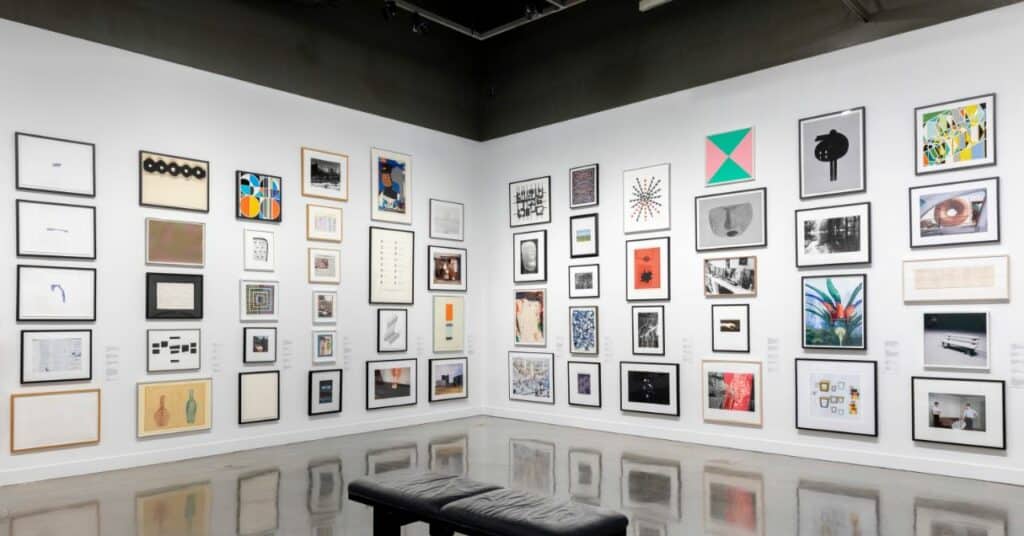“Curate with Confidence: Best Tips for Your Art Exhibition”
In this article on “Art Exhibition: Best Tips for Curating Your Own”, we’ll give you useful information, tips, and advice on how to put together a successful art show. Whether you’re a seasoned artist showing off your newest collection or a new artist excited to show off your work for the first time, these ten tips will help you make your exhibition an event to remember.
Putting together your own art show is more than just a way to show off your skills; it’s a journey into the worlds of art, storytelling, and self-expression. It gives you a chance to share your unique point of view with the world and meet other people who love art as much as you do. Curating your own exhibition can be a rewarding experience, whether you’re a new artist trying to make a name for yourself or a well-known artist putting together a new collection.
In our delightful article Famous Artists and Their Muses, we explore the mysterious connections that led to the creation of famous works of art. Go on an exciting adventure into the world of art and learn about the stories behind famous works of art.
10 Pro Tips for Curating Your Own Art Exhibition
It can be exciting and rewarding to put together your own art show. This is your chance to show off your creative journey and meet other art lovers who like your work. Here are the ten professional art exhibition tips that will help you make sure your art exhibition is a huge success:
1. Define Your Theme

First, come up with a clear idea or theme for your art exhibition. The theme will help you organize your art and give it a story that flows together. It can be based on your own experiences, problems in society, or anything else that speaks to you.
Key Aspects: Define Your Theme
| Aspects | Description |
| Theme Exploration: | Explore personal experiences, emotions, or concepts |
| Coherence: | Ensure theme unifies and connects chosen artworks |
| Inspiration Source: | Identify sources that inspire your chosen theme |
| Storytelling: | The theme should allow for a compelling narrative |
| Emotional Impact: | Consider how theme can resonate with the audience |
| Artwork Selection: | Choose artworks that align harmoniously with theme |
| Flexibility: | Allow room for artistic interpretation within theme |
| Artistic Expression: | The theme should enable meaningful artistic expression |
2. Select Your Best Work

Quality is always better than quantity. Pick out your best pieces to put on display. These should be the pieces of art that best show off your style and message. There will be a bigger effect from a smaller group of high-quality works.
Key Aspects: Select Your Best Work
| Aspects | Description |
| Quality over quantity: | Prioritize your strongest, most impactful pieces. |
| Coherence with Theme: | Choose artworks that align with your exhibition’s theme. |
| Personal Connection: | Select pieces that resonate with you personally. |
| Showcase Diversity: | Include artwork that highlights your versatility. |
| Emotional Impact: | Prioritize works that evoke strong emotions. |
| Audience Engagement: | Consider what will captivate and engage viewers. |
| Consistency in Excellence: | Ensure each piece reflects your artistic excellence. |
| Potential Storytelling Value: | Think about how each artwork contributes to the exhibition’s narrative. |
3. Create A Timeline

Carefully plan out the schedule for your exhibition. Think about how much time it will take to make new art (if needed), frame it, advertise the event, and set up the space for the exhibit. A well-planned schedule will help you stay on track and stress less.
Key Aspects: Create A Timeline
| Aspects | Description |
| Start Early: | Begin planning well in advance of your exhibition. |
| Milestones: | Set clear milestones for tasks like artwork creation. |
| Flexibility: | Allow some flexibility in your timeline for unexpected delays or changes. |
| Prioritize Tasks: | Prioritize tasks based on their importance and dependencies. |
| Realistic Deadlines: | Set realistic deadlines that account for the complexity of each task. |
| Contingency Plans: | Prepare contingency plans for potential setbacks. |
| Team Collaboration: | If you have a team, ensure everyone is aware of the timeline and their responsibilities. |
| Regular Check-Ins: | Regularly review and adjust your timeline as needed. |
4. Choose the Right Venue

It’s very important to choose the right venue. The venue should go with your theme and be able to hold your art well. Make sure it’s easy for your target audience to get to and fits the mood you want to create.
Key Aspects: Choose the Right Venue
| Aspects | Description |
| Alignment with Theme: | Ensure the venue complements your exhibition’s theme. |
| Accessibility: | Choose a venue easily accessible to your target audience. |
| Size: | Ensure the space can accommodate your artwork effectively. |
| Ambiance: | Consider the ambiance of the venue and its suitability. |
| Location: | Select a location that enhances the overall experience. |
| Amenities: | Check if the venue provides necessary facilities. |
| Budget: | Stay within your budget while choosing the venue. |
| Flexibility: | Evaluate the venue’s flexibility for your setup needs. |
5. Lighting Matters

Get the right lighting to make your art stand out. Good lighting can bring out the colours and details in your art, creating an atmosphere that is captivating and draws people in. If you need to, talk to a lighting expert.
Key Aspects: Lighting Matters
| Aspects | Description |
| Quality Lighting: | Invest in high-quality lighting for your exhibition. |
| Highlight Details: | Proper lighting accentuates artwork details. |
| Enhance Colors: | Quality lighting brings out vibrant colors. |
| Create Ambiance: | Lighting sets the exhibition’s overall atmosphere. |
| Professional Advice: | Consult a lighting specialist if needed. |
| Consistency is Key: | Ensure uniform lighting throughout the exhibit. |
| Dimmable Options: | Consider adjustable lighting for flexibility. |
| Highlight Focal Points: | Use lighting to draw attention to key artworks. |
6. Plan the Layout

Plan out the layout of your exhibition space carefully. Think about how the exhibit flows, how far apart the pieces are, and how they are arranged. A layout that looks good and is well-organized can make the whole thing stronger.
Key Aspects: Plan the Layout
| Aspects | Description |
| Flow of the Exhibition: | Ensure a logical flow that guides visitors through the artwork. |
| Spacing Between Artworks: | Maintain consistent spacing. |
| Artwork Arrangement: | Arrange artworks in a visually appealing and cohesive manner. |
| Focal Points: | Create focal points or featured areas. |
| Sightlines and Pathways: | Ensure clear sightlines and well-defined pathways. |
| Accessibility: | Make sure the layout is accessible to all visitors. |
| Balance and Harmony: | Strive for balance and harmony in the placement of artworks. |
| Signage and Descriptions: | Place descriptive signage strategically to provide context. |
7. Write Compelling Descriptions

Write interesting descriptions for each piece of art. These should explain how you came up with the ideas for the show, the story behind each piece, and how it fits with the overall theme of the show. Using descriptive captions can help people feel something when they look at your art.
Key Aspects: Write Compelling Descriptions
| Aspects | Description |
| Clarity: | Ensure descriptions are clear and concise. |
| Connection with Theme: | Relate each description to the exhibition’s theme. |
| Emotional Engagement: | Evoke emotions and connections with viewers. |
| Artistic Process: | Share insights into your creative process. |
| Storytelling: | Narrate the story behind each artwork. |
| Artwork Significance: | Highlight the significance of each piece. |
| Viewer Connection: | Create a connection between art and viewers. |
| Consistency: | Maintain a consistent tone and style. |
8. Promote Your Exhibition

Promotion that works is essential. To get people talking about your art, use a variety of marketing tools, like social media, email newsletters, local media, and websites that are related to art. Use your network, work with other artists, and think about holding a preview event to get people interested.
Want to find out more about fine art than just your own exhibition? You can find a lot of creative ideas and chances to make art on Artsy’s official website. Find, buy, and sell fine art by well-known artists and up-and-coming artists. It’s the entrance to a lively art community that’s just waiting to be discovered!
Key Aspects: Promote Your Exhibition
| Aspects | Description |
| Social Media: | Utilize platforms like Facebook, Instagram, etc. |
| Email Marketing: | Send newsletters and updates to your subscribers. |
| Local Media: | Collaborate with local newspapers and radio. |
| Art-Related Websites: | List your exhibition on art-centric websites. |
| Collaborations: | Partner with other artists or galleries. |
| Networking: | Engage your art community and fellow artists. |
| Preview/Opening Event: | Host a special event to generate buzz. |
| Promotion Material: | Design posters, flyers, and digital assets. |
9. Engage Your Audience

Plan events or activities that people can take part in at your exhibition to make it more interactive. Giving talks, art workshops, or Q&As as an artist can help people understand how you make art and help you connect with them more deeply.
Key Aspects: Engage Your Audience
| Aspects | Description |
| Interactive Events: | Plan activities like artist talks and workshops. |
| Q&A Sessions: | Encourage audience questions and discussions. |
| Artistic Insights: | Share the creative process behind your art. |
| Feedback: | Invite viewer feedback for a deeper connection. |
| Personal Connection: | Foster a sense of connection with your audience. |
| Participation: | Encourage hands-on participation in the art. |
| Storytelling: | Use stories to create emotional connections. |
| Collaborations: | Collaborate with other artists for diversity. |
10. Prepare for Sales

Have a clear plan for how you will sell your art during the show if you want to. Get price lists, ways to pay, and any other paperwork you need ready. Make it easy for people who want to buy your art to do so.
Key Aspects: Prepare for Sales
| Aspects | Description |
| Pricing Strategy: | Determine the prices for each artwork. |
| Payment Methods: | Specify the accepted payment methods. |
| Sales Documentation: | Prepare invoices or sales receipts for transactions. |
| Artwork Availability: | Clearly indicate which artworks are available for sale. |
| Pricing Transparency: | Ensure transparent pricing with no hidden costs. |
| Sales Team : | Assign responsibilities to individuals for handling sales inquiries. |
| Security Measures: | Implement security measures to protect artworks from theft or damage. |
| Delivery/Collection Plan: | Plan how sold artworks will be delivered to buyers or collected by them. |
In our article about famous art exhibitions that are worth the trip, you can explore a world of art and culture. From famous works of art to new, creative displays from today, famous exhibitions will take you on an inspiring journey that will make you want to see more art. Read More Here.
Putting together your own art show can be hard, but it can also be very rewarding. Sharing your artistic vision with the world, connecting with other art lovers, and even making a name for yourself in the art world are all possible through this. You can put together an exhibition that people will remember for a long time if you plan it well, pay attention to the details, and love what you do.
FAQ
How can I find the best location for my exhibition?
Look for venues that fit your theme and can effectively accommodate your artwork. Consider local galleries, community centres, or even unusual locations that fit your artistic vision.
How should I publicise my exhibition?
Make use of a variety of marketing channels, such as social media, email newsletters, local press, and art-related websites. Engage your network and look for opportunities to collaborate with other artists or organisations.
Should I try to sell my artwork at the exhibition?
Selling artwork during your exhibition is entirely up to you. If you do this, make sure you have a well-organized sales process in place, including price lists and payment methods.





